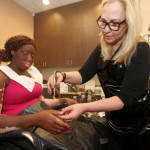Vitiligo in Children

Vitiligo most often affects people between the ages of ten and thirty, which means that children are at a risk of developing it as well. However, Vitiligo in children differs from that in adults as it’s more common in females and because of the young age, association with other systemic autoimmune and endocrine disorders is infrequent.
Although it’s not physically challenging, childhood vitiligo can often have a marked, long-lasting psychosocial effect on your child’s self-esteem, hence understanding the causes, symptoms and adequate treatment options is very essential.
Causes of Vitiligo in Children
Parents often wonder what causes vitiligo. To date there is no concrete understanding of the origin of this skin disease but most pediatricians believe that the complication develops from combinations of poor immunity and genetics as over 30% of affected children have a family member with vitiligo. Experts think it is not related to an environmental issue or a bacterial or fungal skin infection but for some children, simple allergies can prompt an autoimmune response leading to vitiligo. However, it is not contagious – your kid cannot “catch” it from someone else.
Symptoms and Diagnosis of Vitiligo in Children
Vitiligo begins as a small spot on your child’s skin with a color much lighter than the surrounding skin. Over time these light patches may spread and grow while progressively attaining a milky-white appearance. The spread can be fast or slow and can occur symmetrically on both sides of the body or may be limited to just a few areas. Segmental vitiligo, which is more common in children affects only one side of the body and may stop after progressing for a year or two.
Vitiligo can be identified by a dermatologist after a physical examination of your child. The diagnosis is then confirmed after taking into account your child’s medical and family history and rarely, a biopsy (taking a small piece of the affected skin to observe microscopic details). An absence of pigment cells in skin will confirm the diagnosis.
Treatment of Vitiligo in Children
There is no prevention or cure for vitiligo. While a number of treatment options are available, results can vary, and no vitiligo treatment is guaranteed to be 100% effective at making the spots disappear and cause depigmentation.
– Sunscreen and Cosmetics. Make sure your child goes outdoors with sunblock on, to minimize further spread and damage. Concealers can work wonders at giving an even skin tone and making your child more socially comfortable.
– Corticosteroid creams. This type of medication, when used very early in the disease, may help to “repigment” the skin.
– Photochemotherapy with ultraviolet A or B (also known as PUVA or UVB). For PUVA treatment, a medication called psoralen is either applied to the white patches or taken orally. The skin is then exposed to ultraviolet light from a UVA lamp. UVB therapy eliminates the use of psoralen. The treated skin turns pink and then fades to a more natural color. However, it might not be recommended by your doctor because of side effects like severe sunburn, blistering and a risk of skin cancer.











